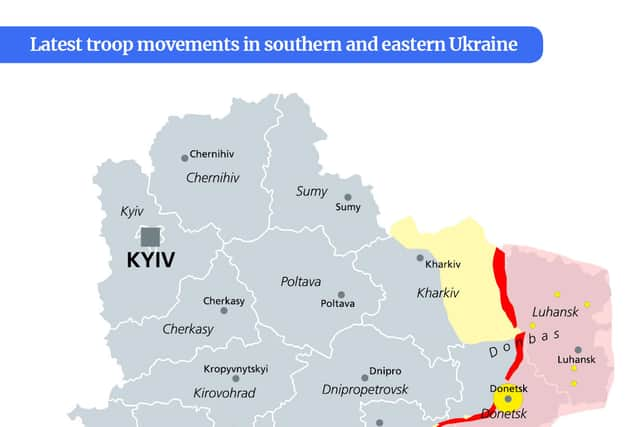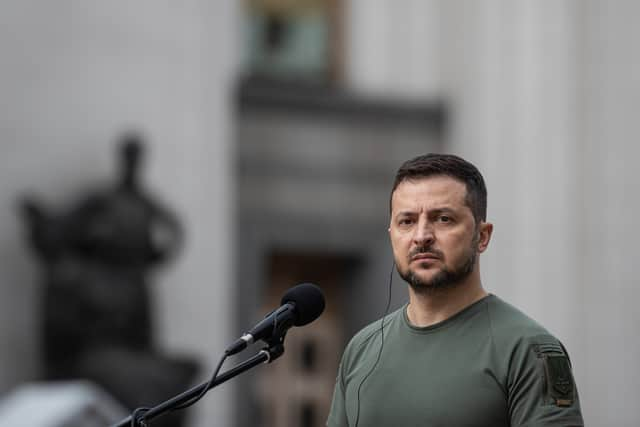Who is winning the war in Ukraine? Current situation and key moments for Ukraine and Russia so far explained
and live on Freeview channel 276
The past 12 months have been unprecedented for Ukraine. The country, which had already been battling Russia in smaller conflicts across areas such as Crimea, was faced with full-scale war after Russian tanks pushed over the border on 24 February, 2022.
Since then, the world has watched on as Ukraine continues to put up a fight against Putin’s troops. Experts predicted a Ukrainian defeat within weeks of the war breaking out, however Volodymyr Zelensky’s men have defied expectation.
Advertisement
Hide AdAdvertisement
Hide AdRecent events in the war have seen Kherson attacked, but over the past few months attention has turned to the political stage. Zelensky made his first visits to countries like the UK and the United States, as well as visiting the European Union in pursuit of military aid, while world leaders such as Joe Biden made high profile trips to Ukraine to signal support.
In the same breath, Vladimir Putin has continued to tell Russians that the war is the result of the West’s intervention. But how is the conflict looking overall - and who is winning one year in?
NationalWorld speaks to James Rogers, co-founder of Council on Geostrategy, about the current state-of-play in Ukraine and what has shaped the conflict over the past year.
Who is winning the war?
Russian troops may not have expected to be at this point one year after invading the wider country of Ukraine, with Ukrainian troops continuing to dig in and try to push Russian forces back. But have their efforts been successful?
Advertisement
Hide AdAdvertisement
Hide Ad“Unfortunately, Russia still occupies a large tract of Ukrainian territory. Remember, this is the largest country beyond Russia in Europe,” explains Rogers. “And in that sense, the land is quite significant in size. The longer they hold onto that, the harder it will become in some respects for the Ukrainians to take it back.”


However, not all hope is lost for a Ukrainian victory. Ukraine has continued to campaign for further support, a campaign which has largely been successful, including the promise of military tanks from the US, the UK and the EU.
“One year in, the Russians have failed in their initial strategic objectives. They have not taken the government over in Kyiv, but they have taken large tracts of Ukrainian territory. And so it remains for the Ukrainians, with all support, to push the Russians out.”
There have been rumours that Russia could be planning a new offensive to coincide with the one year anniversary of the war. But this speculation might be just that.
Advertisement
Hide AdAdvertisement
Hide Ad“It would be so obvious to choose that date,” said Rogers. “And Russia isn’t in a strategic position where it has complete air dominance and complete land dominance. There is significant Ukrainian resistance.
“I think it would be a very foolish move to launch a new push on the year anniversary, because the Ukrainians might well expect that to be a date that would be used.”
How has Western support impacted the conflict over the past year?
The issue of fighter jets has recently hit the headlines, with President Zelensky embarking on a mini tour of European countries to make a plea for military equipment. However, Western leaders have not been quite as forthcoming in providing the jets as they have with other military aid.
Prime Minister Rishi Sunak recently said that the UK would not be sending fighter jets immediately to Ukraine due to the long training period needed. The provision of jets in the future, however, might not be too far off.


Advertisement
Hide AdAdvertisement
Hide AdRogers explains: “We’re seeing a steady ratcheting up of support and I suspect that the next thing on the table will be fighter jets. We’re not entirely sure which variety, but there are several in Western inventories within the Native NATO alliance.
“Already the UK and some other countries are beginning to train Ukrainian fighters, fighter pilots and aviators to Western standards to use those platforms. The support is relentless and ongoing.”
What have been the key moments in the conflict so far?
It’s this support which could mark the difference in Ukraine succeeding in the conflict, according to Rogers. “I think there are ultimately two key moments. The first is the decision by countries like the UK to provide Ukraine with not so much a blank cheque, but significant military and financial support, because that stiffened the resistance of the Ukrainian state and shored up the government of Volodymyr Zelensky.”
This support has come from not only leaders of the West’s largest countries, but also Ukraine’s neighbours. Some Baltic states have continued their commitment to a Ukrainian victory by sending as much as 1% of their GDP to the country.
Advertisement
Hide AdAdvertisement
Hide AdRogers adds: “That is incredibly important and it’s not clear how long the Ukrainians could continue to fight without that kind of support.”
Why has Zelensky been so important to Ukraine’s fight?
There is no doubt that President Zelensky has become one of the most recognisable names and faces on the planet after his decision to stay and fight in Ukraine when Russian troops invaded. It is this decision which Rogers says has been the second-most important moment of the war.
“I think it galvanised the entire country and turned it into the relatively effective fighting machine that we see today, or at least a machine that can resist and can galvanise support in the West, in the native bloc and beyond it, in countries in the Indo-Pacific.”
It has been this symbol of strength and stability in Zelensky that has undoubtedly brought Ukraine to where it is today in the war.


Advertisement
Hide AdAdvertisement
Hide AdRogers explains his significance to the fight: “He has mobilised the international community, particularly the key powers in the West. He has gone around all the key parliaments, all the key centres of decision making, whether that’s Warsaw or London or Brussels or Washington, Paris and Berlin as well as other countries, to gain support, to argue for Ukraine’s case and to remind everyone that the narrative that Russia has been pushing out for years in relation to Ukraine [is] all basically false.”
“I think also it’s been important in reminding governments in Europe and North America and elsewhere just how much is at stake here. If Ukraine fails, this will not be the end of the matter in Russia under the current regime - it will not go away. It will be incredibly emboldened, because it will be victorious.”
Comment Guidelines
National World encourages reader discussion on our stories. User feedback, insights and back-and-forth exchanges add a rich layer of context to reporting. Please review our Community Guidelines before commenting.
